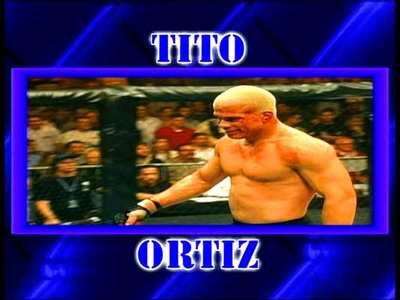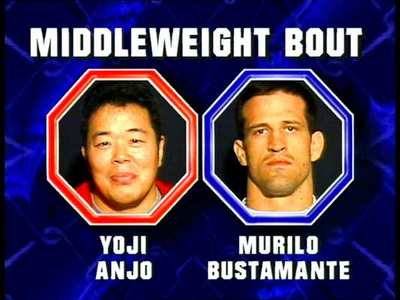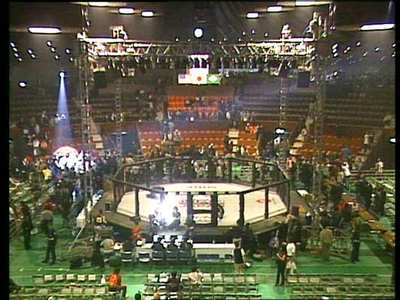Review of UFC: 25 & 26
Introduction
In the year 2000, things were not looking good for the Ultimate Fighting Championship. The originality that had made the company popular in the early 1990s had dwindled, and there was much political opposition to the group, often from those who were ignorant to the product.
To fans looking back on those days, this period is referred to as the UFC Dark Ages. Thankfully, in the years to come, UFC would find itself regulated in almost every American state (without any real rule changes, I might add), and would go on to find more popularity in 2006 than any other pay-per-view entity.
UFC 25 & 26 occurred towards the end of the SEG (parent company) period, before UFC was bought by the current incumbents, Zuffa. UFC 25: Ultimate Japan III was held on 14th April 2000, from the Yoyogi National Gym in Tokyo, Japan, and was headlined by a mouth-watering bout between Tito Ortiz and Wanderlei Silva. UFC 26: Ultimate Field of Dreams, was held on 8th June 2000, at the Five Seasons Events Centre in Cedar Rapids, Iowa, headlined by Kevin Randleman vs. Pedro Rizzo.

Video
Video is presented in 4:3 fullscreen PAL, and is generally very good for a DVD of this genre. For both UFC 25 & 26, the DVD transfer is excellent, although the actual events` production values do not quite meet that standard. In particular, UFC 25 has a minimalist approach, within the rather dark confines of the Yoyogi National Gym. The Octagon cage is always well lit, but the remainder of the arena is very dark indeed. UFC 26 fares better, although it clearly doesn`t have the glamour that the more recent UFC shows certainly have.

Audio
Audio is presented in Dolby Digital 2.0, and is good for a DVD of this genre. Everything is clear, from ring introductions, to in-Octagon action, to commentary, which is provided on both events by Mike Goldberg and Jeff Blatnick. Goldberg describes the action well, and Blatnick is particularly good at describing fighter strategy, especially on the ground.
I must make mention of the extremely quiet Japanese audience at UFC 25. Commentator Blatnick described them as "eerily different" to their American counterparts, and in this instance, not in a good way. The lack of crowd participation took away from the matches, something which would not have occurred with a more vociferous American audience.

Features
There are no extras on this set.

Conclusion
UFC 25: Ultimate Japan III began in rather ignominious fashion, as Laverne Clark and Koji Oishi fought a Middleweight contest that was both long, and featured much too much stalling. In the same weight class, at least Ikuhisa Minowa vs. Joe Slick was a little better, with a couple of moments of brilliance from the eventual winner, including a beautiful suplex in the second round.
There was a huge size differential in the next bout, as Ron Waterman faced Satoshi Honma. There was some brutal striking on show in this long match, but the fight was not as competitive as I would have hoped.
Eugene Jackson then engaged with Sanae Kikuta, in a match which Jackson almost pulled out of, due to a bad bout of flu (no doubt jet lag also proved to be a problem). As such, this wasn`t a typical Jackson performance, though it was a reasonable match nonetheless.
It was indeed better than the proceeding encounter, in which Murilo Bustamante faced pro wrestler Yoji Anjo, famous in Japan for once turning up at unannounced Rickson Gracie`s gym in Brazil, and demanding a match with him there and then. The story goes that Anjo threatened several of Gracie`s students, at which point someone telephoned the sleeping Gracie at home to inform him of the disturbance. Gracie apparently taped up his fists whilst he drove to the gym, took up Anjo`s challenge immediately, and brutalised him to Rocky IV levels. One would have thought that Anjo would thus have had more sense than to anger another Brazilian, but no. This bout ended, as expected, with an awesome submission manoeuvre.
That just left us with the main event, an incredible-sounding contest between Tito Ortiz and Wanderlei Silva, for the UFC Middleweight Title. Unfortunately, however, it was not quite as good as the names suggest, with much more ground-work occurring here than in any other Silva fight that I can recall. Most of the work was very good technically, but watching Silva employ his jiu-jitsu skills is like watching Diego Maradona playing in goal - his skills are so much more suited to a stand-up fight.
On to UFC 26, then, where the first bout of the night was a Bantamweight contest (weight classes were soon to be renamed by the Nevada Athletic Commission) between Jens Pulver and Joao Roque. Unfortunately, the match failed to provide the entertainment usually synonymous with the 155lb weight division, as Roque refused to engaged in a stand-up contest with Pulver, and Pulver similarly refused a Jiu-Jitsu scenario with Roque.
In his second ever UFC appearance, Matt Hughes then appeared for a bout with Marcelo Aguiar, one which is notable for some interesting corner-man coaching, which is clearly audible here. The bout is typically hard-hitting, especially after a laceration is incurred by one of the participants.
Amaury Bitetti and Alex Andrade were then up next, in a match which proved both brilliant and farcical. Brilliant was the fight`s first round, full of top-quality striking. Farcical, sadly, was the bout`s conclusion.
The Lightweight Title was then on the line, as champion Pat Miletich faced John Alessio, the latter aged only 20. You didn`t need to know that statistic, however, to see the huge difference in Octagon experience here, but even at that, this was a good match. It was certainly better than the proceeding Tyrone Roberts vs. David Dodd encounter, though, that featured very little true action, nor any real attempt by either fighter to finish.
I made mention of the UFC Dark Ages in my opinion paragraph, and if there was ever a bout that symbolised those pre-Zuffa days, it was our main event of Pedro Rizzo challenging Kevin Randleman for the UFC Heavyweight Title. Fought to a backdrop of intense audience dis-satisfaction, this bout is without question one of the very worst in UFC (or indeed, MMA) history, ranking up there with disasters such as Severn vs. Kimo (PRIDE 1) and Severn vs. Shamrock (UFC 9). Virtually nothing happened for the entire duration, with both men apparently scared of the other`s strengths, which were Randleman`s wrestling and Rizzo`s striking. Not that, from this match, you`d know either had any positive qualities at all.
Looking at UFC 25 & 26 overall, there are not too many reasons to search this one out as your next FightDVD purchase. Of the twelve bouts on offer, I enjoyed just five of them, with another four truly fast-forward material. Of the five acceptable bouts, none were must-see match-ups, making UFC 25 & 26 one release for the collector only.
Your Opinions and Comments
Be the first to post a comment!